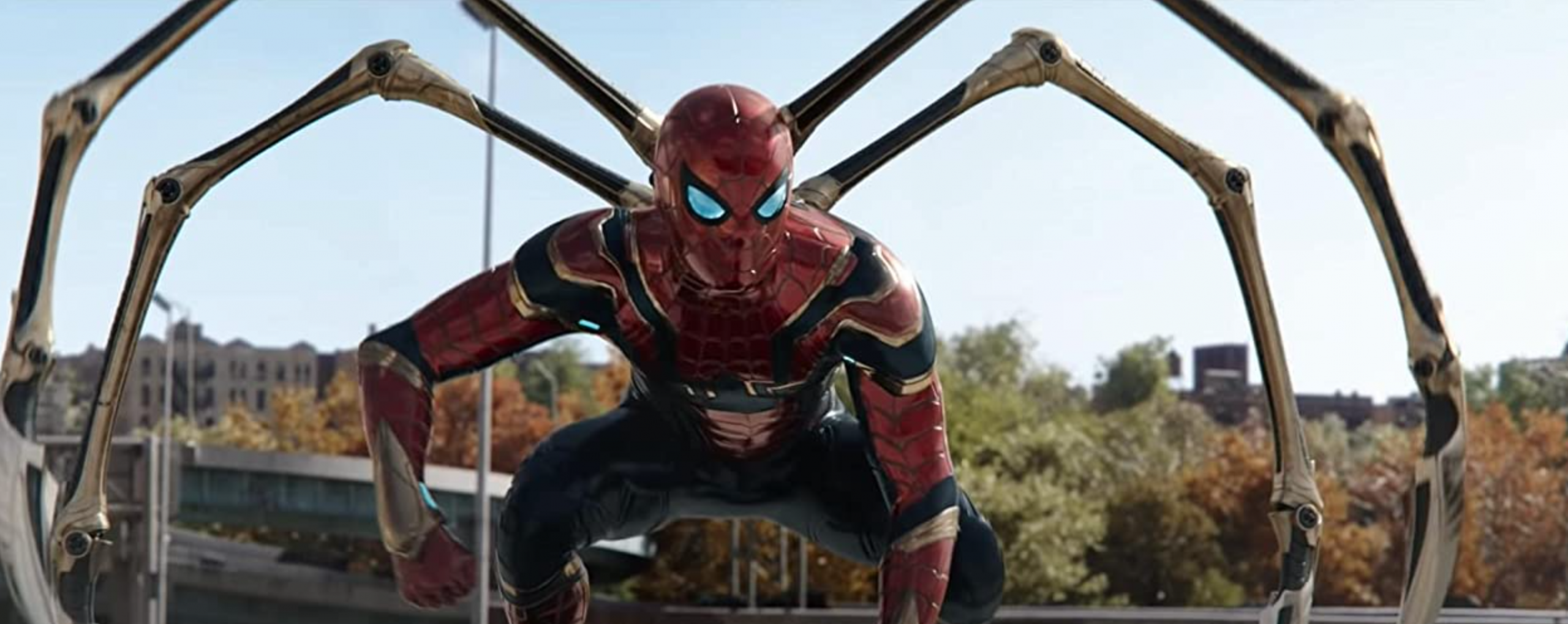With a groundbreaking debut of $600.8 million at the global box office, Marvel Studios’ highly anticipated Spider-Man: No Way Home hit theaters on December 17, quickly taking the world by storm. As with any blockbuster in a major franchise, especially the Marvel Cinematic Universe, the film was shrouded in mystery the moment its trailer was released in August. Packed to the brim with cameos and nostalgia, No Way Home is undeniably exciting and accomplishes almost everything desired by fans; its disappointing ending, however, partially takes away from that satisfaction.
The movie picks up seconds after Spider-Man: Far From Home (2019) ends—a harrowing cliffhanger in which Mysterio (Jake Gyllenhaal) frames Spider-Man (Tom Holland) for his murder, as well as the weaponized use of Stark Industries’ drones and the endangerment of countless lives. The last frame of Far From Home has Mysterio outing Spider-Man’s identity as Peter Parker on live television, serving as the catalyst for the events of No Way Home.
No Way Home sees Peter Parker turn to Doctor Strange (Benedict Cumberbatch) in an attempt to protect those around him by erasing the world’s memory of his identity as Spider-Man. One thing leads to another, however, and a botched spell causes everything to fall apart: a breach into the multiverse is opened, and the villains from every previous Spider-Man movie are beckoned into Peter Parker’s universe. Leaning into nostalgia to heighten the anticipation and dread of these villains, the film reintroduces Green Goblin (Willem Dafoe) from Spider-Man (2002), Doc Ock (Alfred Molina) from Spider-Man 2 (2004), Electro (Jamie Foxx) from The Amazing Spider-Man 2 (2014), Sandman (Thomas Haden Church) from Spider-Man 3 (2007), and Lizard (Rhys Ifans) from The Amazing Spider-Man. Faced with an array of dangerous adversaries, Peter must rectify his mistakes by healing each villain of their superhuman maladies and returning them to their universes.
No Way Home’s high stakes are foreshadowed from the start, as director Jon Watts creates a compelling, fast-paced introductory sequence. Grabbing his girlfriend MJ (Zendaya) by the waist, Spider-Man swings through the city in a desperate attempt to escape the growing crowd and government helicopters surrounding them. As Peter reaches his apartment and brings Aunt May (Marisa Tomei) and Happy Hogan (Jon Favreau) into the mix, the camera relies on whip-panning to simultaneously create an air of urgency and maintain light-hearted comedy—the kind of dual tone central to this newest installment in the Spider-Man trilogy.
The opening sequence hints at the extent of fan service to come: Matt Murdock (Charlie Cox), better known as Daredevil in the Marvel TV show of the same name, makes a cameo as Peter’s lawyer. His spotlight moment is short yet effective, delighting audience members who are fans of Daredevil, while ensuring that those who are unfamiliar with the lesser-known character do not feel alienated.
Significantly greater than Murdock’s cameo, however, is the incorporation of the five Spider-Man villains. For those who grew up reading the comics or watching Andrew Garfield and Tobey Maguire’s Spider-Men, witnessing the iconic villains wreak havoc on the big screen once more is especially riveting. Molina’s Doc Ock entertains with snarky comments about the multiversal swap, and Foxx’s Electro is strikingly funny through witty one-liners. Dafoe’s Green Goblin is particularly interesting this time around, deceiving Spider-Man and the audience into believing that his innocent alter-ego, Norman Osborn, is still in control. Despite the chaos threatened by all five foes, Green Goblin stands out as the greatest antagonist of No Way Home. Just as our web-slinging hero is on the cusp of successfully curing each villain, the Goblin turns on him, inciting a violent revolt that leads to one of the most enthralling action sequences of the film. Peter has been through battering fights before, such as in Avengers: Infinity War (2018) and Avengers: Endgame (2019), but somehow, this comes across as the worst one yet; maybe it’s the physical trauma he’s enduring, thrown through consecutive condominium floors, or maybe it’s the crushing realization that he messed up enormously and doesn’t have a team of superheroes to back him up this time around.
Holland is profoundly captivating during the battle, as always, but it is the latter part of the scene that encapsulates his skills as an actor: May dies in Peter’s arms as he begs her to live, desperately shaking her through disbelieving tears. Holland’s performance is poignant and vulnerable, demonstrating his ability to convey deep-rooted pain and remind the audience that Peter Parker is, at the end of the day, just an 18 year-old kid. May insists mere seconds before her death that “with great power, comes great responsibility,” a monumental quote in all three generations of Spider-Man and one that seals the exchange as a tear-jerker.
As Peter suffers a gut-wrenching defeat, MJ and their friend Ned (Jacob Batalon) elevate the film to an entirely different level: they accidentally open a portal that brings Andrew Garfield and Tobey Maguire’s renditions of Spider-Man into the fold. This is where No Way Home begins to exceed expectations like no other Marvel movie—even Avengers: Endgame—in its shock factor. The theater erupted into screams of disbelief when Garfield’s Peter leapt through the wormhole and pulled off his mask, unveiling one of the most awaited cameos of this movie. After a hilarious, lovable interaction between Garfield’s Spidey, MJ, and Ned, Maguire’s character emerges, eliciting another round of hollering from the audience. From here on out, No Way Home is incomparable to not only other Marvel movies, but also its opening half. Even Spider-Man: Into the Spider-Verse (2018), which centers on seven iterations of the web-slinging hero, lacks this level of impact; No Way Home brings back beloved Spider-Men rather than introducing new characters, and ultimately, that makes all the difference.
A subsequent rooftop scene between all three Spideys draws together Holland, Garfield, and Maguire in an emotionally-charged moment. For the rest of the film, the dialogue between them adds well-timed emotion and comedic relief, living up to the way that fans have always imagined the three versions of Peter Parker interacting. A humorous bit between Garfield and Maguire in the final battle, for instance, involves back-cracking and positive self-talk—exactly the type of mundane topics one would expect between the millennial Spider-Men.
When it comes to fan service, the audience’s enthusiasm peaks in the final battle of No Way Home, set to the eye-catching backdrop of the Statue of Liberty. The ultimate climactic moment sees the three Spider-Men leap from the scaffolding to fight side-by-side against their villains, swinging across one another and working in perfect tandem. The visuals in this battle scene are a cinematic spectacle, a complex and impressive display of how far CGI has come since the days of the older Spider-Man films. Backed by a brilliant score by Michael Giacchino, the excitement of watching three generations of Spider-Men on the same screen is only heightened. In one heartstopping instant, MJ falls from the top of the Statue of Liberty, helpless and petrified, as Holland’s Peter Parker jumps after her and is knocked out of the way by a drone. MJ’s free fall is a heartbreaking parallel to that of Garfield’s love interest, Gwen Stacey (Emma Stone), in the Amazing Spider-Man movies. Both expectantly and emotionally, then, it is Garfield’s Spider-Man that dives after MJ without hesitation, managing to save her after having failed Gwen. Moments like this exemplify how No Way Home rewards devoted fans of the web-slinging hero: Garfield’s iteration of Peter Parker is finally redeemed after losing Gwen, and Garfield himself finally receives the attention he lacked during the Amazing Spider-Man era.
One final fight between Holland’s Spider-Man and the Goblin pulls the focus back to this era’s Peter Parker, ensuring that the movie has not gotten too swept away by its nostalgic cameos. As with every stunt coordinated for No Way Home, the hand-to-hand combat is done remarkably well, and Holland’s performance once again delivers as Peter is overcome by vengeance and nearly beats his foe to death. Convinced otherwise, however, Peter and his new teammates revert the Goblin back to his harmless alter-ego, and it becomes time to bid a bittersweet farewell to the veteran Spider-Men. When Holland grips Maguire and Garfield tight in a hug, repeatedly and sincerely thanking them for all of their help, it’s clear that his gratitude extends far beyond their fictional characters.
No Way Home satisfies long-time fans by balancing humor and emotion in a highly anticipated team-up between the three generations of Spider-Men. Its ending, however, might leave fans of the new trilogy less than satisfied. In a last-ditch effort to prevent every person who knows of Peter Parker’s existence from coming through a multiversal tear, our Peter agrees to have Doctor Strange cast a spell erasing his identity from the minds of everyone who knows of him, including MJ and Ned. A tearful, crushing goodbye between Peter and his best friends underscores how upsetting this ending is; Zendaya breaks the audience’s hearts as MJ stumbles over her words in denial, questioning why they can’t find another solution and confessing her love for Peter. Although the young hero insists that he will reunite with his friends and remind them of their history together, the next scene proves otherwise: Peter finds MJ and Ned in their staple coffee shop, and, unable to bring himself to upend the lives they have only just begun repairing, leaves them with no recollection of what they’ve lost. The last shot of No Way Home shows Peter Parker moving into a small apartment, ready to continue his life as both Spider-Man and an adult, utterly alone. In spite of this heartbreaking reminder of everything the movie has cost Peter, this scene sets up the possibility of a college trilogy—a clean slate to continue the story of Holland’s Peter Parker, without any obligation to what was established in the Homecoming trilogy.
For fans who prefer Garfield or Maguire’s renditions of the web-slinging hero, No Way Home might have been a dream come true, and a relatively fulfilling last installment in a trilogy they are less attached to. Yet for fans who prefer Holland’s Spider-Man or are even mildly invested in the characters and relationships forged over the past five years, the ending likely felt disappointing, even unwarranted. It leaves too many questions surrounding Peter Parker’s relationship with MJ, his friendship with Ned, and the next steps in his education. Without confirmation that Holland will be reprising his role sometime in the future, these questions only exacerbate the let-down. Story-wise, the decision might have been for the best—but in a film entirely committed to fan service, the ending drops the ball.
However, there is no denying the thrill that every audience member experienced as the three Spider-Men joined forces to fight off five iconic villains. All in all, Spider-Man: No Way Home is fan service executed brilliantly, and its outstanding box office success certainly indicates it.





